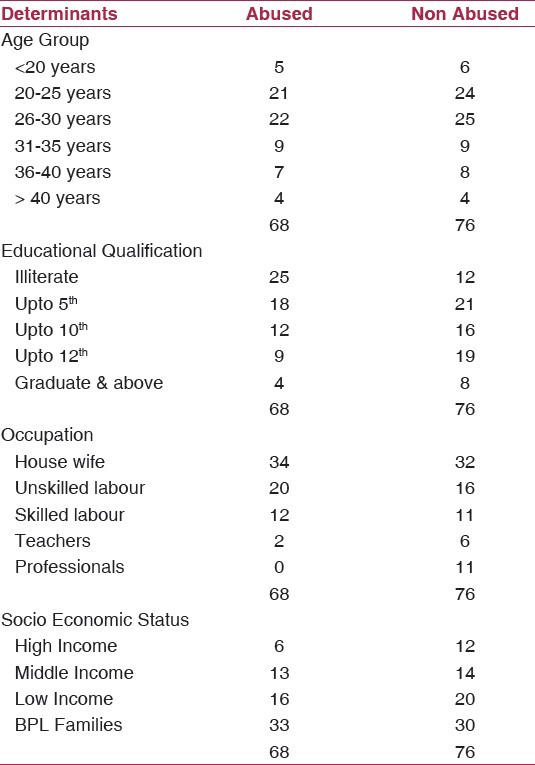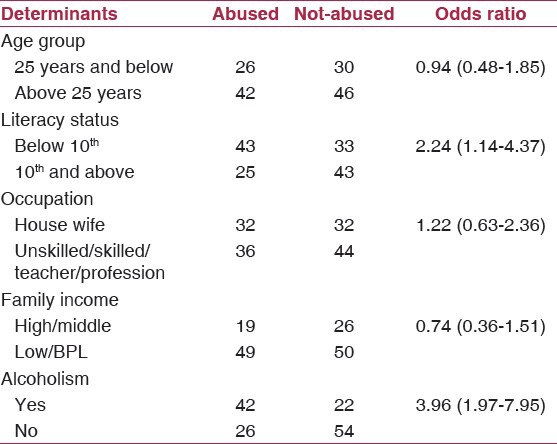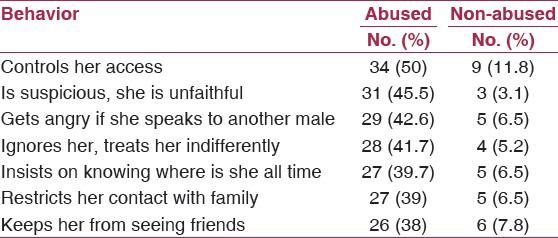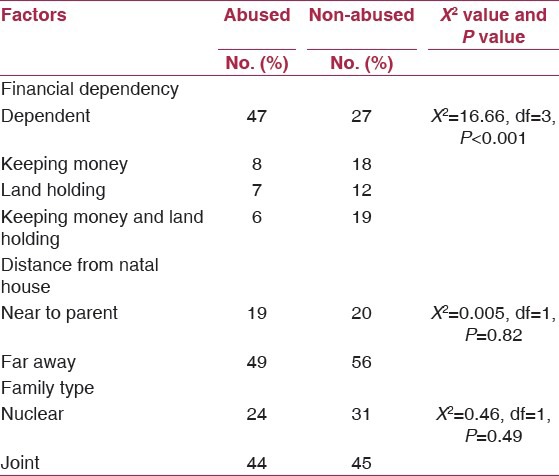Abstract
Background:
Violence against women is a universal phenomenon that persists in all communities and in all countries of the world and the perpetrator of that violence is often well-known to the victim. Domestic violence in particular continues to be frighteningly common and well-accepted as “normal” within too many societies.
Objectives:
(1) The primary aim of this study is to find out the extent of different type of domestic violence and to identify various risk factors for domestic violence against married women. (2) The secondary aim is to identify the various protective factors of domestic violence against married women.
Materials and Methods:
The present study was a population based cross-sectional study carried out in the urban area of Gwalior city for a period of one year. Stratified random sampling technique was used for the selection of the samples. The study participants were interviewed using a pretested semi-structured open-ended questionnaire. Proportion, Pearson's, chi-square test and odds ratio were calculated for the analysis of the study.
Result:
Of the 144 study participants, 68 participants reported some form of domestic violence, which was either physical, sexual or emotional. The most common type of violence reported was physical violence. The most important risk factor for domestic violence was alcoholism followed by literacy status. Majority of the abused women were dependent on their husbands for money, material assets and expenditure.
Conclusion:
The study hereby recommends that to prevent domestic violence government has to take stringent action for making women more self-reliant especially by making the women more literate and more financially independent.
Keywords: Domestic violence, emotional violence, physical violence, sexual violence
Introduction
Violence against women is a universal phenomenon's that persists in all communities and in all countries of the world and the perpetrator of that violence is often well-known to the victim. Domestic violence in particular continues to be frighteningly common and well-accepted as “normal” within too many societies.
A landmark multi-centric study designed and carried out by World Health Organization (WHO) in association with London School of Hygiene and Tropical Medicine and Program for Appropriate Technologies in Health had clearly stated that domestic violence is not inevitable in all the societies. The study noted that prevalence of physical violence varied from 13% to 61% in different societies among counties included in the study.(1)
Violence against women was never a serious concern for the government and society prior to 1996. Global gathering such as World Conference on Human Right (Vienna 1993), International Conference on Population and Development (Cairo 1994) and Fourth World Conference on women (Beijing 1995) have helped a lot in drawing attentions of heads and policy makers from different states to this major issue. These gatherings have helped a lot in developing a perspective that the issue of domestic violence cannot be solved by a single intervention, but it may require a multi-sectoral approach for its prevention.
Government of India has made serious effort in curbing the problem of domestic violence by the formation of “Protection of Women from Domestic Violence Act, 2005,” which stated that “any act, conduct, omission and commission that harms or injures or has a potential to harm or injure will be considered as Domestic Violence by the law.”(2)
However, even in the presence of this act, we have a gloomy picture. In depth analysis of National Family Health Survey-3 (NFHS-3) (2006-2007) carried out by Kimuna et al. showed that the prevalence of physical violence among Indian women is as high as 31% and that of sexual violence is also as high as 8.3%.(3)
The prevalence of women suffering from any type of domestic violence in Madhya Pradesh is 45.8% which is way ahead of national average and Madhya Pradesh is thus ranked third in the list of states having a high prevalence of domestic violence just after Bihar and Rajasthan in the NFHS-3 data.(4)
Thus, the present study was designed with the following objectives:
To find out the extent of different type of domestic violence and to identify various risk factors for domestic violence against married women.
To identify the various protective factors of domestic violence against married women.
Materials and Methods
Study design and study period
The present study was a population based cross-sectional study carried out in the urban area of Gwalior city for a period of 1 year from 1st May 2009 to 30th April 2010 by the staff and students of Department of Community Medicine, G. R. Medical College, Gwalior.
Study area
Gwalior is one of the biggest cities in Madhya Pradesh with a total urban population of 1053305 with 588753 males and 513229 females. The city is divided into three regions – namely Morar, Hazira and Lashkar, which have in total 60 wards.
Study universe
The study includes all the married women who were living with their husband for last 1 year.
Sample size and sampling
The sample size was calculated using the formula
 (5)
(5)
P (prevalence rate) was taken as 30% (it based on the finding of in depth analysis of NFHS-3 data by Kimuna et al. who showed the prevalence of physical violence to be 31%).(3)
D = Absolute precision of 5%
DEFE = design effect = 1.5
The sample was calculated to be 121 using a 95% of confidence interval. The sample was further inflated to 150 to round up the figure.
Stratified random sampling technique was used for the selection of the samples. Gwalior city has a total of 60 wards which were numbered from 1 to 60 and of this 10 wards were selected randomly using random number table and in each selected wards, 15 eligible participants were identified using house-to-house visit.
Methodology
For the selection of the study participants, two teams were formulated comprising of one faculty member and two postgraduate students from the Department of Community Medicine. Before the start of the study, all the team members were briefed about the aims and objectives of the study and standardization of study protocol was carried out. The study proforma was pretested on 20 subjects to see whether it fulfilled the study objectives and required modification were made later on.
The team members reached the selected wards and a fixed point was located which was any fixed structure with public utility e.g., temple, school etc. From the fixed point the team members moved in the left hand direction until the required sample size per wards was found. The study participant was defined as any legally married woman of age 18 years and above and living with her husband for more than 1 year. From each household only one eligible female was included in the study for an in depth interview provided she gave her informed consent for the participation in the study. If two or more than two eligible women were present the youngest one was included provided she fulfilled the eligibility criteria and gave informed consent for the participation in the study.
The study participants were assured about the confidentiality of the interview and that the interview would not be discussed with any of the other family members. The option of withdrawal at any stage of the study was always available to them. Before the actual start of the study, the study protocol was put in front of the Institutional Review Board and necessary ethical clearance was sorted.
The study proforma was developed and pretested before the actual study was undertaken. It was a semi-structured open ended type and sorted information on the following broad headings: Socio-demographic profile, type of violence and associated factors and protective factors.
All the information gathered was transferred into suitable statistical software on the weekly basis and proportion, Pearson's Chi-square test and odds ratio were calculated for the analysis of the study.
Result
In the present study, a total of 178 eligible participants were contacted so that the desired sample size of 150 study participant could be achieved. Of this 28 refused to give the informed consent for the participation in the study. However, out of 150 study participants 6 did not complete the study pro forma, thus the total sample size was limited to 144, which was more than the desired sample size of 121.
Of the 144 study participants, 68 reported some form of domestic violence which was either physical, sexual or emotional violence. Majority of the study participants was in the age group of 26-30 years and were Hindu by religion [Table 1].
Table 1.
Showing the distribution of the participants on the basis of Socio Demographic Profile

The most common type of violence reported was physical violence along with an emotional violence followed by physical violence along with sexual violence [Table 2].
Table 2.
Showing the Distribution of different types of domestic violence

It was noted in the present study that the most important risk factor for the domestic violence was alcoholism followed by literacy status [Table 3].
Table 3.
The distribution of the participants on the basis of risk factors

It was noted that the range of behavior control was more in the abused than in non-abused and it varies from 50.5% to 36.2% in abused to 11.8-4.6% in non-abused persons [Table 4].
Table 4.
Distribution of various behavior controlling acts

Majority of the abused women were dependent on their husbands for money, material assets and expenditure [Table 5].
Table 5.
The distribution of various protective factors of domestic violence

Discussion
In the present study, prevalence of domestic violence is 47.2%, which is in accordance with the findings of NFHS-3 for Madhya Pradesh.(4) Most common type of domestic violence noted in the present study is a combination of physical and emotional violence followed by physical violence alone. This is against the finding of multi-centric study carried out by the WHO, which reported only physical violence as the most common violence followed by physical and sexual violence.(1) This difference could be attributed to the fact that our study participants were more shy in discussing sexual violence.
The most common age group of abused women in the present study is 26-30 years followed by 20-25 years. This is similar to the finding of Yoshikawa et al.(6)
It was noted in the present study that the prevalence of domestic violence is least among graduate and above and maximum among the illiterate participants. This is in accordance with the fact that there is a strong association between the literacy status and vulnerability to being abused. A statistically significant odds ratio of 2.24 (95% confidence interval [CI]: [1.14-4-37]) is noted between the literacy status of less than 10th std. education and being abused. Kimuna et al.(3) also noted it to be one of the key determinants for domestic violence in India. Thus, we can say that education can be considered as one of the protective factors from domestic violence.
It was also noted in the present study that the prevalence of domestic violence was the most among housewives among House wives compared to other occupations. An association is also being noted between housewife and being abused in the present study, odds ratio was calculated to be 1.37 (95% CI: [0.711-2.655]). Babu and Kar(7) also noted that housewives are more prone to psychological and sexual violence than women involved in other occupations.
Similar association was also noted with the family income. As the socio-economic status of the family decreases, the prevalence of domestic violence increases. However, in the present study this association is not statistically significant. This could be attributed to the fact that our study was carried out on a small sample size. A bigger study with a larger sample size will be required to find out this association. Studies carried out by other researchers had shown a strong association between family income and domestic violence.(1,3,7,8,9) This could be attributed to the fact that as the purchasing power of the family decreases there will be an increasing degree of frustration in the family members that will ultimately result in some form of domestic violence.
The present study has also noted a very strong association between alcohol intake and domestic violence. Odds ratio was calculated to be 3.96 (95% CI: [1.976-7.955]) Kimuna had also noted that being a wife of a man who drank alcohol increases the odds ratio of experiencing physical and sexual violence.(3) Studies carried out both in India and globally have also noted this phenomenon.(9,10,11,12,13)
It was observed in the present study that the husband of abused women exercise more control over the behavior of their wives compared to non-abused women. The most common behavior control was the control over their access to other things which may be friends, health-care, movement to other places like markets etc. Other things such as suspicion about their wife's faithfulness, getting angry if she talks to other male, ignorance etc., was also more among abused women than non-abused women. Simlar behavior was also noted in the study carried out by Simmons and lehmann(14) and Lechmann et al.(15)
It was noted in the present study that financial independency, distance from the natal house and family type can be considered as one of the protective factors from domestic violence. Financial dependence has a strong statistical association with domestic violence. Studies carried out by Jeyaseelan et al.(8) have also concluded that financial independence is one of the important protective factor from the domestic violence. Similar association has also been noted with a distance from natal house. If the distance from the natal house is far there is an increased chance of getting abused. There is an increased chance of domestic violence among couples residing in nuclear family as compared to joint family. These finding can be attributed to the fact that there is more social support, which can act as a buffer from domestic violence. These finding are in line with the findings of different studies carried out both nationally and internationally.(1,8,13,14,15,16)
Conclusion
The present study hereby concludes that in India combination of physical and emotional violence is the most common type of domestic violence, which has a strong association with alcoholism and literacy status of women. The study has an implication for those involved in the control of domestic violence in India. The study hereby recommends that to prevent domestic violence government has to take stringent action for making women more self-reliant especially by making the women more literate and more financially independent.
Footnotes
Source of Support: Nil
Conflict of Interest: None declared.
References
- 1.Geneva: WHO; 2005. World Health Organization. Who Multi-Country Study on Women's Health and Domestic Violence against Women: Initial Results on Prevalence, Health Outcomes and Women's Responses. [Google Scholar]
- 2. [Last accessed on 2013 May 23]. Available from: http://www.lawyerscollective.org/files/protection_of_women_from_domestic_violence_act_2005.pdf .
- 3.Kimuna SR, Djamba YK, Ciciurkaite G, Cherukuri S. Domestic violence in India: Insights from the 2005-2006 national family health survey. J Interpers Violence. 2013;28:773–807. doi: 10.1177/0886260512455867. [DOI] [PubMed] [Google Scholar]
- 4. [Last accessed on 2013 May 25]. Available from: http://www.rchiips.org/nfhs/pdf/Madhya%20Pradesh.pdf .
- 5. [Last accessed on 2013 May 21]. Available from: http://www.openepi.com/OE2.3/Menu/OpenEpiMenu.htm .
- 6.Yoshikawa K, Agrawal NR, Poudel KC, Jimba M. A lifetime experience of violence and adverse reproductive outcomes: Findings from population surveys in India. Biosci Trends. 2012;6:115–21. doi: 10.5582/bst.2012.v6.3.115. [DOI] [PubMed] [Google Scholar]
- 7.Babu BV, Kar SK. Domestic violence against women in eastern India: A population-based study on prevalence and related issues. BMC Public Health. 2009;9:129. doi: 10.1186/1471-2458-9-129. [DOI] [PMC free article] [PubMed] [Google Scholar]
- 8.Jeyaseelan L, Kumar S, Neelakantan N, Peedicayil A, Pillai R, Duvvury N. Physical spousal violence against women in India: Some risk factors. J Biosoc Sci. 2007;39:657–70. doi: 10.1017/S0021932007001836. [DOI] [PubMed] [Google Scholar]
- 9.Shrivastava PS, Shrivastava SR. A study of spousal domestic violence in an urban slum of Mumbai. Int J Prev Med. 2013;4:27–32. [PMC free article] [PubMed] [Google Scholar]
- 10.Sinha A, Mallik S, Sanyal D, Dasgupta S, Pal D, Mukherjee A. Domestic violence among ever married women of reproductive age group in a slum area of Kolkata. Indian J Public Health. 2012;56:31–6. doi: 10.4103/0019-557X.96955. [DOI] [PubMed] [Google Scholar]
- 11.Stuart GL, Moore TM, Ramsey SE, Kahler CW. Hazardous drinking and relationship violence perpetration and victimization in women arrested for domestic violence. J Stud Alcohol. 2004;65:46–53. doi: 10.15288/jsa.2004.65.46. [DOI] [PubMed] [Google Scholar]
- 12.Stuart GL, Moore TM, Elkins SR, O’Farrell TJ, Temple JR, Ramsey SE, et al. The temporal association between substance use and intimate partner violence among women arrested for domestic violence. J Consult Clin Psychol. 2013;81:681–90. doi: 10.1037/a0032876. [DOI] [PMC free article] [PubMed] [Google Scholar]
- 13.Tran TD, Tran T, Wynter K, Fisher J. Interactions among alcohol dependence, perinatal common mental disorders and violence in couples in rural Vietnam: A cross-sectional study using structural equation modeling. BMC Psychiatry. 2012;12:148. doi: 10.1186/1471-244X-12-148. [DOI] [PMC free article] [PubMed] [Google Scholar]
- 14.Simmons CA, Lehmann P. Exploring the link between pet abuse and controlling behaviors in violent relationships. J Interpers Violence. 2007;22:1211–22. doi: 10.1177/0886260507303734. [DOI] [PubMed] [Google Scholar]
- 15.Lehmann P, Simmons CA, Pillai VK. The validation of the checklist of controlling behaviors (CCB): Assessing coercive control in abusive relationships. Violence Against Women. 2012;18:913–33. doi: 10.1177/1077801212456522. [DOI] [PubMed] [Google Scholar]
- 16.Decker MR, Nair S, Saggurti N, Sabri B, Jethva M, Raj A, et al. Violence-related coping, help-seeking and health care-based intervention preferences among perinatal women in Mumbai, India. J Interpers Violence. 2013;28:1924–47. doi: 10.1177/0886260512469105. [DOI] [PMC free article] [PubMed] [Google Scholar]


